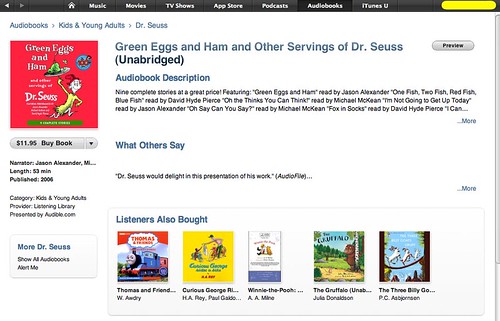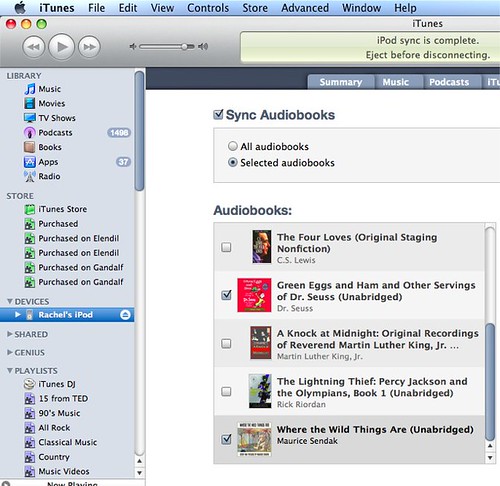Over the years our family has purchased various iPod models, and we tend to pass them down by age. Currently, this means my six year old daughter is the proud owner of a 2 GB second generation iPod Nano purchased in 2006. That was payment for her sister’s work (who was then about to enter kindergarten) in helping me lead a multi-day workshop about podcasting with Garageband for teachers in College Station, Texas. Although Rachel is VERY cognizant of her iPod’s limitations (it won’t play videos) she is also VERY proud of it and loves to use it. Being in a family of readers who not only read paper books and eBooks, but also listen to AudioBooks, Rachel has naturally decided she wants to listen to AudioBooks as well – and she recently realized should COULD do that on her iPod Nano. Last night she announced her desire to buy some AudioBooks in advance of an upcoming car trip to visit family in Kansas, so we explored the iTunes Store together and discovered two suitable titles which caught her interest.
In addition to learning about how to purchase AudioBooks online, this experience also provided a great opportunity to contextually explore concepts of simple division. I wrote a bit about that in a blog post on our family learning blog. Rachel was VERY excited to learn that THIRD graders usually learn about simple division (according to her sister) but she’s JUST getting ready for FIRST grade. It’s never too early to discuss how important and useful math skills can be, especially in practical contexts!
Rachel was very interested to learn how we were going to buy these books online. She gave me half the money for her purchase ($6.50) from her own savings, and then drove the mouse as we used my iTunes account to purchase the books. She was SO excited to watch the progress bar advance as each book was downloaded to our computer!
After downloading both books, on her iPod in iTunes Rachel chose to synchronize the two AudioBooks she’d purchased.
Of course, she immediately wanted to go to her room and start listening to these AudioBooks! How thrilled she was that this worked, and she now has her OWN AudioBooks on her iPod!
After she’d listened awhile, I asked her to record a short podcast (using iPadio and the free iPhone iPadio app) about her experiences and what she learned.
It is great to see how much confidence and fluency my own children continue to develop as the result of frequent practice activities like this – talking about what they have learned in different real-world, meaningful contexts. Rachel and I listened to her recording afterwards, and she commented on how she says “uh” a lot. Of course I pointed out she does a WONDERFUL job explaining her ideas clearly, and how proud I am of her – But that she can continue to work on not saying “uh” as much when she makes podcasts. (I definitely continue to work on this too!) This conversation shows how valuable self-recording can be, and the process of listening to ourselves talk. Rachel has greater self-awareness about her own voice and speaking skills as a result of these activities tonight.
I commented this afternoon to my wife I think one effect of the standards movement in education in our country has been to intimidate some parents (and perhaps even some teachers) when it comes to helping young people develop their literacy skills. I am not saying this to diminish the importance of formal education and training when it comes to literacy development – by all means, I think those programs can be VERY valuable. I do think, however, that a great deal of literacy development is NOT rocket science. We need to read a lot. We need to be read TO a lot. We need to engage in the activities and behaviors of literate people FREQUENTLY: Listening to others, asking good questions, being asked good questions, discussing our thoughts, and writing about our ideas. Audio recording platforms like iPadio provide an ideal tool to document and share these types of learning situations.
I realize our opportunities to use audio recording technologies like iPadio as a family are different in many ways from the constraints under which classroom teachers work every day. I firmly believe, however, we need to be using technology tools like this to document our thinking and share our learning MUCH MORE than we are today. It’s not only valuable to share what we are thinking and learning with others, it’s also insightful as well as powerful to LISTEN to ourselves (as Rachel did tonight) discuss our learning.
Literacy isn’t rocket science. It also can be extremely FUN to develop together!
Technorati Tags:
apple, audiobook, audiobooks, child, download, itunes, learn, literacy, math, purchase, read, reading, student, together, excitement





Comments
6 responses to “Helping a six year old learn about iTunes AudioBook purchases and simple division”
Here is another fun way for children to engage with technology and learning http://cloudworks.ac.uk/cloud/view/4103
Awesome post and a great use of iPadio with your daughter for reflective and self-evaluative purposes! I recently added iPadio to our family’s iPad after reading about it on your blog and now I am anxious to begin to create my own family podcasts. My wife and I have twin 10-year-old boys and we still revisit and model the iTunes Store/Sync process with them frequently.
About a year ago, we created individual iTunes accounts for them so that they could download and manage their iTunes purchases on their own laptops and iPods. We have found that iTunes gift cards make great stocking stuffers and small rewards for the boys. We’ll buy a $50 set of $10 gift cards and hand them out as the occasions arise.
This gift card method allows the boys to add the money onto their iTunes account, make purchases, manage the balance and make their own decisions about spending wisely on apps. From a parents standpoint, it works out great because we do not have to put in our credit card information on the boys accounts, rather, they can buy apps until the balance on their account hits zero:)
Love the family focus to this and many of your other posts, Wes. It’s great to see how other parents are using technology in daily life to create and enhance anytime, anyplace learning opportunities for their families!
Jeremy: Thanks for the feedback. 🙂
I agree personal iTunes accounts are great for kids managing their own money as well as purchases. Lots of good conversations can take place around this! I learned from Tony Vincent last year how to create iTunes accounts without a credit card, which is also very good – this way, kids can’t spend beyond their gift card balance.
Everyone in our family shares the same iTunes library, which is stored on an external hard drive I sync periodically with my laptop to all our mobile devices. The thing I really noticed this week (when I went through this process) is how important it is to have everyone home – Whoever bought a particular app with their account has to enter THEIR password to download the update. It made me think this will get tough if we still have these same apps when they go to college! Of course by then we may all be syncing our devices to virtual drives “in the cloud” – More likely the kids will migrate entirely to their own accounts on their own laptops at some point. For now, however, it’s great to be able to share apps and music, just as we do with Amazon Kindle eBooks when we buy them on the same account.
I’m so glad to have inspired you to try iPadio with your family – I really am amazed how easy it is relative to other methods of web-posting audio. I hope they don’t go the way of Gcast or Gabcast!
If you’re willing I’d love to get the links to your family blog / podcast channel. I think we need to encourage more personal use of technology like this for family learning as well as classroom learning! Last year at NECC (2009) I presented on The Power of Our Family Learning Blog.
My post last July, “What’s your media platform for knowledge sharing?” and this March’s post “Platforms for idea sharing are essential (even family learning blogs)” both reflect my belief that we ALL can benefit in multiple ways when we maintain “platforms for knowledge sharing.”
I’m sure in about 12 years when all our kids are out of high school, we’ll be looking back at these examples of their thinking and work with fondness – remembering these shared times of learning, and enjoying the window they provide into the development as well as personality of each child.
Wes,
Great story…thanks for sharing. I’m glad you mentioned the part about the standards movement having an intimidating effect on some parents when it comes to helping develop literacy. Some are so intimidated that they farm out these wonderful family learning opportunities to tutoring agents and agencies-I can’t imagine if the Fryer household used tutors in place of the wonderful experiences that you describe here. It just wouldn’t be the same, would it?
~Matt
Wesley,
very nice and touchy post.
I’ve just taught my son how to use mac photo recoverytool.